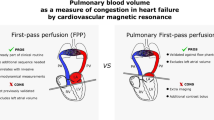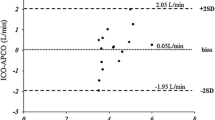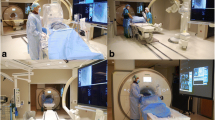Abstract
We sought to compare pulmonary flow hemodynamic indices obtained by Fick and thermodilution catheterization techniques with phase-contrast MRI (PC-MRI) in children with diverse etiologies of pulmonary arterial hypertension (PAH). Calculation of pulmonary flow (\({\dot{\text{Q}}}_{\text{p}}\)) using the Fick principle in most catheter laboratories relies on an estimate of oxygen consumption which may limit its reliability. Flow hemodynamic indices acquired from thirty patients with PAH who underwent successful same-day PC-MRI and catheterization were evaluated for absolute and percent bias. Comparison of \({\dot{\text{Q}}}_{\text{p}}\) between PC-MRI and Fick revealed poor agreement with an absolute bias of 0.96 ± 0.53 L/min/m2 and percent bias of 27.7 ± 19.6%. Same analysis between PC-MRI and thermodilution revealed better agreement as demonstrated by absolute bias 0.64 ± 0.47 L/min/m2 and percent bias 16.8 ± 12.3%. Retrospectively calculated \({\dot{\text{V}}}_{{{\text{O}}_{2} }}\) from PC-MRI and LaFarge equations revealed poor agreement, with an absolute bias of 33.4 ± 21.6 mL/min/m2 and percent bias of 25.8 ± 12.6%. We found that Fick-derived flow hemodynamics dramatically differs from PC-MRI computed metrics in children with PAH. The non-invasive nature of PC-MRI and short acquisition time is ideal for pediatric flow evaluation and may offer a novel route of absolute flow and resistance assessment when combined with cardiac catheterization.


Similar content being viewed by others
References
Abman SH, Hansmann G, Archer SL et al (2015) Pediatric pulmonary hypertension. Circulation. doi:10.1161/CIR.0000000000000329
Ivy DD, Abman SH, Barst RJ et al (2013) Pediatric pulmonary hypertension. J Am Coll Cardiol 62:D117–D126
Hansmann G, Apitz C, Abdul-Khaliq H et al (2016) Executive summary. Expert consensus statement on the diagnosis and treatment of paediatric pulmonary hypertension. The European Paediatric Pulmonary Vascular Disease Network, endorsed by ISHLT and DGPK. Heart 102:ii86–ii100
Hoeper MM, Lee SH, Voswinckel R et al (2006) Complications of right heart catheterization procedures in patients with pulmonary hypertension in experienced centers. J Am Coll Cardiol 48:2546–2552
Ploegstra M-J, Arjaans S, Zijlstra WMH et al (2015) clinical worsening as composite study end point in pediatric pulmonary arterial hypertension. Chest 148:655–666
Hopper RK, Abman SH, Ivy DD (2016) Persistent challenges in pediatric pulmonary hypertension. Chest 150:226–236
Ploegstra M-J, Zijlstra WMH, Douwes JM et al (2015) Prognostic factors in pediatric pulmonary arterial hypertension: a systematic review and meta-analysis. Int J Cardiol 184:198–207
Li J, Bush A, Schulze-Neick I et al (2003) Measured versus estimated oxygen consumption in ventilated patients with congenital heart disease: the validity of predictive equations. Crit Care Med 31:1235–1240
Del Cerro MJ, Moledina S, Haworth SG et al (2016) Cardiac catheterization in children with pulmonary hypertensive vascular disease: consensus statement from the Pulmonary Vascular Research Institute, Pediatric and Congenital Heart Disease Task Forces. Pulm Circ 6:118–125
Seckeler MD, Hirsch R, Beekman RH, Goldstein BH (2015) A new predictive equation for oxygen consumption in children and adults with congenital and acquired heart disease. Heart 101:517–524
Rutledge J, Bush A, Shekerdemian L et al (2010) Validity of the LaFarge equation for estimation of oxygen consumption in ventilated children with congenital heart disease younger than 3 years: a revisit. Am Heart J 160:109–114
Fixler DE, Carrell T, Browne R et al (1974) Oxygen consumption in infants and children during cardiac catheterization under different sedation regimens. Circulation 50:788–794
LaFarge CG, Miettinen OS (1970) The estimation of oxygen consumption. Cardiovasc Res 4:23–30
Downing TE, Whitehead KK, Dori Y et al (2013) Accuracy of conventional oximetry for flow estimation in patients with superior cavopulmonary connection. Circ Cardiovasc, Imaging, p 6
Rogers T, Ratnayaka K, Lederman RJ (2014) MRI catheterization in cardiopulmonary disease. Chest 145:30–36
Van Ooij P, Powell AL, Potters WV et al (2016) Reproducibility and interobserver variability of systolic blood flow velocity and 3D wall shear stress derived from 4D flow MRI in the healthy aorta. J Magn Reson Imaging 43:236–248
Nayak KS, Nielsen J-F, Bernstein MA et al (2015) Cardiovascular magnetic resonance phase contrast imaging. J Cardiovasc Magn Reson 17:71
Stalder AF, Russe MF, Frydrychowicz A et al (2008) Quantitative 2D and 3D phase contrast MRI: optimized analysis of blood flow and vessel wall parameters. Magn Reson Med 60:1218–1231
Harloff A, Nußbaumer A, Bauer S et al (2010) In vivo assessment of wall shear stress in the atherosclerotic aorta using flow-sensitive 4D MRI. Magn Reson Med 63:1529–1536
Dyverfeldt P, Bissell M, Barker AJ et al (2015) 4D flow cardiovascular magnetic resonance consensus statement. J Cardiovasc Magn Reson 17:72
Truong U, Fonseca B, Dunning J et al (2013) Wall shear stress measured by phase contrast cardiovascular magnetic resonance in children and adolescents with pulmonary arterial hypertension. J Cardiovasc Magn Reson 15:81
Schäfer M, Ivy DD, Barker AJ et al (2016) Characterization of CMR-derived haemodynamic data in children with pulmonary arterial hypertension. Eur Hear J. doi:10.1093/ehjci/jew152
Martin Bland J, Altman D (1986) Statistical methods for assessing agreement between two methods of clinical measurement. Lancet 327:307–310
Muthurangu V, Taylor A, Andriantsimiavona R et al (2004) Novel method of quantifying pulmonary vascular resistance by use of simultaneous invasive pressure monitoring and phase-contrast magnetic resonance flow. Circulation 110:826–835
Beerbaum P, Körperich H, Barth P et al (2001) Noninvasive quantification of left-to-right shunt in pediatric patients: phase-contrast cine magnetic resonance imaging compared with invasive oximetry. Circulation 103:2476–2483
Beerbaum P, Körperich H, Gieseke J et al (2003) Rapid left-to-right shunt quantification in children by phase-contrast magnetic resonance imaging combined with sensitivity encoding. Circulation 108:1355–1361
Wentland AL, Grist TM, Wieben O (2014) Review of MRI-based measurements of pulse wave velocity: a biomarker of arterial stiffness. Cardiovasc Diagn Ther 4:193–206
Author information
Authors and Affiliations
Corresponding author
Ethics declarations
Conflicts of interest
All authors report to have no conflict of interest.
Rights and permissions
About this article
Cite this article
Schäfer, M., Truong, U., Browne, L.P. et al. Measuring Flow Hemodynamic Indices and Oxygen Consumption in Children with Pulmonary Hypertension: A Comparison of Catheterization and Phase-Contrast MRI. Pediatr Cardiol 39, 268–274 (2018). https://doi.org/10.1007/s00246-017-1751-1
Received:
Accepted:
Published:
Issue Date:
DOI: https://doi.org/10.1007/s00246-017-1751-1




